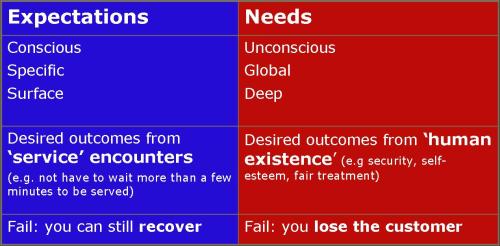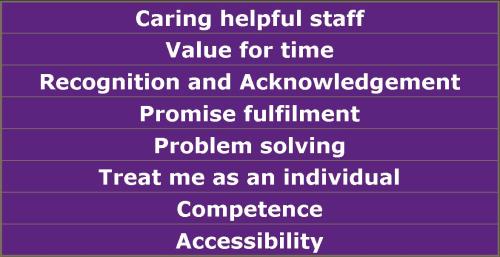How do you view your business, your industry?
One of the most useful posts I have come across recently is one by Mark Hurst at Good Experience. It gets to the heart of the matter quickly and I encourage you to read it: “Your industry has the wrong name”
Mark’s key point is worth memorising: “To create a good customer experience, you need to see your job as dealing with people as they deal with your field of work.”
Now if your job is dealing with people then it really helps if you understand a little about people.
There is a big difference between Expectations and Needs
Let’s start by distinguishing between Expectations and Needs. Too many people lump them together and that is a mistake: they are not equally important and violating Needs has very different consequences to violating Expectations.
When you are dealing with people then you have to cater for both Expectations and Needs. Why? Taken as a whole they determine how people (your customers) approach events and situations. And how they are likely to behave in response to events and situations.
Yet, there are also big differences. Expectations are wrapped around daily events, specific and much more readily available to the conscious mind. For example, you will have an expectation as to how long you should wait to get your meal at McDonalds. And this is likely to be very different to your expectations as to how long it will take your main course to arrive at a fine restaurant. Furthermore, when you make comparisons you will compare McDonalds with other fast food restaurants. And you will compare the fine restaurant with other fine restaurants.
Needs on the other hand are much more global and they tend to be hidden from view: submerged in the subconscious mind. Needs arise from our existence as human beings: they concern issues of life and death and how we see ourselves (our identity). If your job is dealing with people as they deal with you field of work then you need to pay attention to three needs in particular:
- security – the need to feel secure and as such not threatened by harm (physical, economic, psychological);
- esteem – the need to maintain and enhance one’s self-esteem and social standing; and
- justice – the need to be treated fairly as a human being of worth.
Why am I making such a big fuss between Expectations and Needs? Two reasons:
First, if you dissatisfy customers by not meeting their expectations, you can still recover. Whereas, if you dissatisfy customers by violating their basic needs, you are likely to lose them. Would you do business with a dishonest supplier? Would you do business with a supplier that made you feel stupid or lose face in public? Would you take the family car in for a service to the garage who failed to tighten the bolts properly last time and as a result your front wheel dropped off whilst you were driving (with your young children in the back)?
Second, I believe that too many customer experience efforts are overly focussed on Expectations and are neglecting the Needs. Even worse, some customer experience designers are improving performance against Expectations at the expense of Needs.
B2C: what matters most to your customers?
So what matters most to customers when it comes to the B2C space? All kinds of research has been done and you can choose your favourite one. Personally, I find the following table useful:
At the very top of the wish list is caring helpful staff. Why is that? Because caring helpful staff tend to deliver on the three key needs simultaneously: security, esteem and justice. Put differently, caring helpful staff get that their job is to deal with customers as people whilst these customers deal with your field of work.
The flip side is that if you want your customers to look for another supplier and to speak badly of you then employ uncaring, unhelpful staff. Or, employ caring helpful staff and then put them in a culture that prevents them from being caring and helpful by tying them up with unfriendly business policies and practices.
For the record, I am of the view, that the real culprits are unfriendly business policies and the associated culture (rather than the employees who serve customers). You don’t have to take my word for it, read this post from the highly ranked 1to1 Blog: “Do Your Policies Work Against Your Company?”





![[Research Round-Up] New Study Shows the Continuing Value of B2B Thought Leadership](https://customerthink.com/wp-content/uploads/development-2010010_1280-pixabay-innovation-ideas-think-1-218x150.jpg)